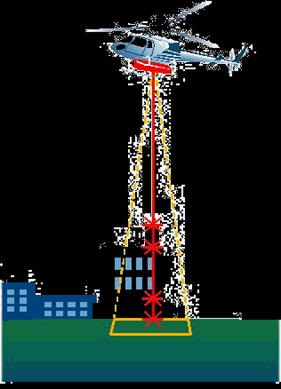Sources of Electromagnetic Radiation
Objectives
As shown in the illustration below, there are three main sources of electromagnetic radiation that are used in remote sensing:
- solar radiation, in other words natural radiation that originates from the sun
- terrestrial radiation, in other words natural radiation emitted by the Earth's surface
- artificial radiation originating from a remote sensing system

We will now consider the physical processes underpinning natural and artificial radiation sources in turn.
Natural radiation
Natural radiation can be detected by a sensor as a result of one of two processes. As shown in the illustration above, incident radiation from the sun can be reflected from the Earth's surface. Such reflected radiation is typically in the visible, near and middle infra-red wavelengths. It can also be emitted by the Earth's surface. Such emitted radiation is typically of a longer wavelength, in the middle and far infra-red wavelengths.
These phenomena are governed by Wien's displacement law, which describes how the amount and wavelength of radiated energy relates to the temperature of a given substance. Wien's law states 'when the temperature of a blackbody radiator increases, the overall radiated energy increases and the peak of the radiation curve moves to shorter wavelengths'. For now, we will skip over the complexity implied here by the term blackbody radiator and focus on what this law means for remote sensing. Under Wien's law, the wavelength of the spectral peak of the energy radiated by a body is given by:
λm = 2897.8 / T (where λm is the wavelength of the spectral peak and T is the temperature in degrees Kelvin of a given body)
Clearly, the sun has a much higher temperature (ca 6000 degrees K) than the Earth (ca 303 degrees K) and so the overall energy radiated by the Earth is lower and has its peak at a longer wavelength. This is why radiation emitted from the Earth is at the longer middle and far infra-red wavelengths, compared with the shorter wavelengths of reflected solar radiation. The relationship is illustrated by the figure below.
More generally, there are 3 key concepts that underpin the way that sources of electromagnetic radiation behave:
- Radiant energy (Q) is the energy that an electromagnetic wave contains
- Irradiance (L) is the total amount of such energy incident on a point on a surface from all directions above the surface
- Radiant exitance (M) is the total amount of energy leaving a point on a surface to all directions above the surface.
These concepts are shown graphically below.

These three concepts - radiant energy, irradiance, and radiant exitance - are all inter-related and vary in line with the temperature of a given body. As illustrated in the animation below, this has implications for what we can achieve with remote sensing and in general terms, it makes remote sensing of cooler objects a more problematic exercise than sensing of hotter objects.
Artificial radiation
Artificial radiation occurs where a remote sensing instrument sends its own energy pulse towards the Earth's surface. The characteristics of the back-scattered energy from this pulse can then be recorded by a sensor onboard the same instrument. Typically, such sensors can record the time taken by the pulse to travel from the instrument to the target and back again to the instrument's sensor, as well as the strength of the echo received from the object. Calculating the travel time of the pulse can involve working with information about the phase of the return pulse. Remote sensing systems that make use of artificial radiation are often referred to as active remote sensing systems, in contrast to passive systems, which rely on natural sources of radiant energy. Active remote sensing systems can be further classified according to the wavelength of the energy used. Radar remote sensing systems emit an electromagnetic pulse, which is then detected as an incident radar wave on an onboard sensor. An airborne radar remote sensing system is shown in the illustration below.

Laser remote sensing systems, such as LiDAR, may have variable wavelengths that are used for both pulses and their subsequent detection by onboard sensors. As shown in the illustration below, such systems are typically airborne.

Test your Knowledge
Feedback
False
The DMSP-OLS is part of a passive remote sensing system because it relies on natural rather than radiation. The slight complication in this case is that the source of the natural radiation being sensed is sunlight reflecting off the moon's surface, rather than directly from the sun itself.